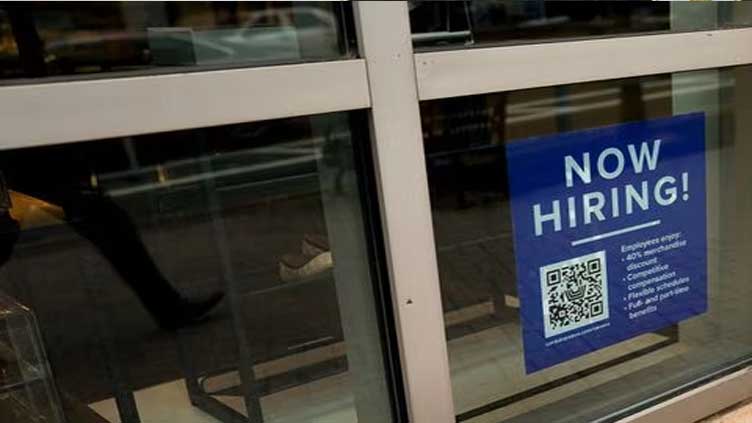US job openings hit more than two-year low; labor market still tight

Business
US job openings hit more than two-year low; labor market still tight
WASHINGTON (Reuters) - U.S. job openings fell to the lowest level in more than two years in June, but remained at levels consistent with tight labor market conditions, which could spur the Federal Reserve to keep interest rates elevated for some time.
Labor market resilience was underscored by the third straight monthly decline in layoffs as employers hoard workers after difficulties finding labor during the COVID-19 pandemic. There were 1.61 job openings for every unemployed person in June, up from 1.58 in May.
The report from the Labor Department on Tuesday, however, suggested workers are growing a bit less confident in the labor market, with resignations plunging by the most since April 2020. Fewer workers changing jobs over time bodes well for slowing wage growth and ultimately overall inflation.
"While today's report discusses data from June, this continued strength in the labor market is likely to keep Fed officials hawkish," said Eugenio Aleman, chief economist at Raymond James in St Petersburg, Florida.
Job openings, a measure of labor demand, dropped 34,000 to 9.582 million as of the last day of June, the lowest level since April 2021, the Job Openings and Labor Turnover Survey, or JOLTS report, showed.
Economists polled by Reuters had forecast 9.610 million job openings.
There were an additional 136,000 job openings in healthcare and social assistance, while vacancies increased by 62,000 in state and local government, excluding education.
Transportation, warehousing and utilities had 78,000 fewer open positions, likely as bottlenecks in the supply chain eased. Unfilled jobs in state and local government education dropped by 29,000, while the federal government had 21,000 fewer vacancies.
The job openings rate was unchanged at 5.8% in June.
Following on the heels of data last month showing inflation subsiding considerably in June, the JOLTS report strengthened views that the economy was headed for the Fed's desired "soft landing" rather than a recession. The U.S. central bank has hiked its policy rate by 525 basis points since March 2022, with the most recent increase occurring last week.
Many economists do not anticipate further hikes in the current tightening cycle, though much will depend on upcoming employment and inflation data.
Hiring dropped 326,000 to 5.905 million, the lowest level since February 2021. That lowered the hires rate to 3.8%, the lowest since the first wave of the pandemic, from 4.0% in May.
The decline in hiring was concentrated in durable goods manufacturing as well as finance and insurance.
Layoffs and discharges fell 19,000 to 1.527 million.
Workers are showing less appetite to seek greener pastures. Resignations dropped 295,000 to 3.772 million. As a result, the quits rate, viewed as a measure of labor market confidence, fell to 2.4% from 2.6% in May.
"This is important, as wages tend to be correlated with the quits rate, with a six-month lag, and the Fed needs wage growth to slow if it is to end its rate hiking campaign," said Matthew Martin, U.S. economist at Oxford Economics in New York.
Stocks on Wall Street were trading lower. The dollar rose against a basket of currencies. U.S. Treasury prices fell.
MANUFACTURING STABILIZING
While the labor market remains defiant, higher borrowing costs are hurting manufacturing, though factory activity appears to have stabilized at weaker levels in July.
The Institute for Supply Management (ISM) said in a separate report that its manufacturing PMI edged up to 46.4 last month from 46.0 in June, which was the lowest reading since May 2020.
It was the ninth straight month that the PMI stayed below the 50 threshold, which indicates contraction in manufacturing, the longest such stretch since the 2007-2009 Great Recession. Economists had forecast the index would rise to 46.8.
Of the six biggest manufacturing industries, only petroleum and coal products reported growth.
Views from manufacturers were mixed. Transportation equipment makers said "demand is softening." Manufacturers of fabricated metal products reported "stable demand for the next four to six months, but longer-term uncertainty."
Machinery makers said "suppliers are starting to reach out looking for new business." Miscellaneous manufacturers reported that "sales remain higher than forecast," but also noted that "supplier capacity issues remain."
The ISM survey's forward-looking new orders sub-index increased to 47.3 in July, the highest reading since October 2022, from 45.6 in June.
Persistent order weakness is weighing on prices for inputs, resulting in goods disinflation that is helping to dampen price pressures in the economy. The survey's measure of prices paid by manufacturers rose to a still-low 42.6 in July from 41.8 in June amid the significant improvement in supply chains.
With orders still depressed, factory employment is shrinking. The survey's gauge of factory employment dropped to 44.4, the lowest reading since July 2020, from 48.1 in June.
According to the ISM, responses from companies indicated "a slowdown in hiring, with attrition, freezes and layoffs actively in place" to match declines in production.
It has, however, not been a reliable predictor of manufacturing employment in the government's nonfarm payrolls count. Factory employment has largely increased this year.
Manufacturing employment likely rose by 5,000 jobs last month, according to a Reuters survey of economists. Overall nonfarm payrolls are forecast to rise by 200,000 jobs in July after increasing by 209,000 in June. The Labor Department is due to release the employment report for July on Friday.
"A small margin of slack has opened in the economy, which will help inflation to slow further in the second half of 2023," said Bill Adams, chief economist at Comerica Bank in Dallas.


